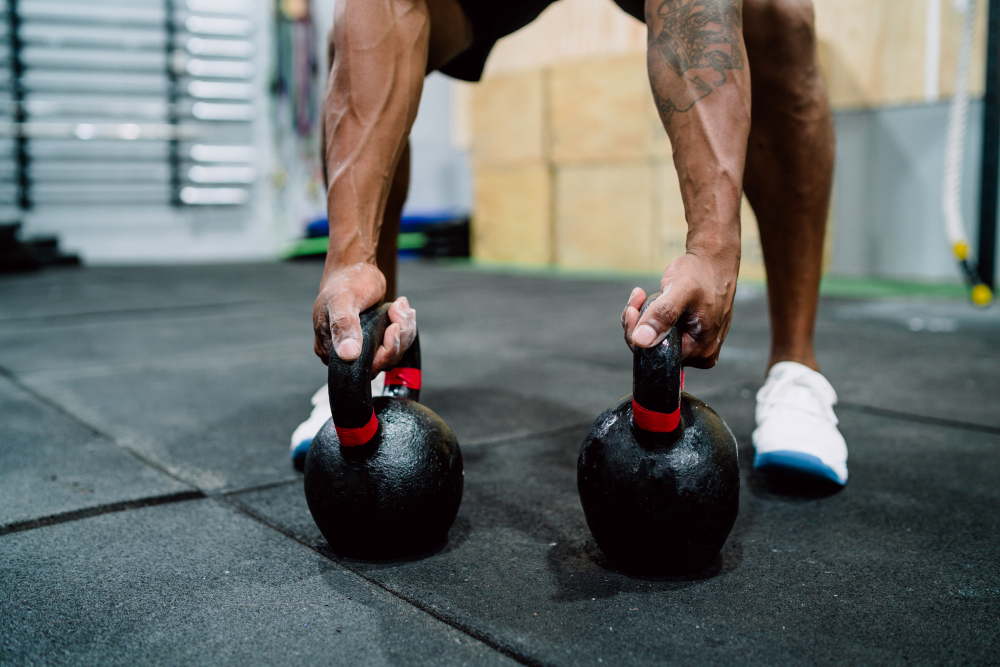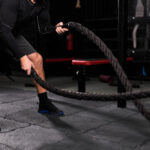If you’re bored of jogging on treadmills or slogging through another cookie-cutter circuit, it’s time to step up your training game. This battle rope and kettlebell HIIT workout is a full-body assault that blends raw power, grit, and serious conditioning. Ropes torch your upper body and lungs, while kettlebells demand strength, stability, and explosive hip drive. Put them together, and you’ve got a workout that’s fast and effective.
Why Battle Ropes and Kettlebells Pair So Well
Battle ropes drive high-intensity, cyclical movements that elevate heart rate almost immediately. They target the upper body in a way most cardio equipment doesn’t, engaging shoulders, arms, and core while demanding continuous output. This kind of work recruits fast-twitch muscle fibers and rapidly depletes anaerobic energy stores. All of this makes it perfect for short bursts of HIIT.
Kettlebells, meanwhile, bring structured resistance. Movements like swings and squats emphasize the posterior chain, hip hinge mechanics, and core stability. They improve strength, power, and coordination while also challenging cardiovascular endurance when performed for higher reps.
Together, ropes and kettlebells create a balanced training effect: metabolic conditioning from ropes, functional strength from kettlebells. The result is a workout that improves muscular endurance and promotes the “afterburn effect” (EPOC), meaning your body keeps burning calories long after you stop.
Sample of Battle Rope and Kettlebell HIIT Workout
This kind of workout is best when intensity is high and rest is short. Think 30-40 seconds of maximum effort, followed by 15-20 seconds of rest. One round should include four to five movements, repeated for 3-5 total rounds depending on fitness level.
Example Circuit:
- Battle Rope Slams – 30 seconds
-
-
- Focus: full-body power, especially shoulders, arms, and core.
- Cue: drive through your legs, not just your arms.
-
- Kettlebell Swings – 30 seconds
-
-
- Focus: posterior chain (glutes, hamstrings, lower back).
- Cue: hinge at the hips, avoid squatting the movement.
-
- Alternating Rope Waves – 30 seconds
-
-
- Focus: endurance and shoulder stability.
- Cue: keep waves even, minimize torso rotation.
-
- Kettlebell Goblet Squats – 30 seconds
-
-
- Focus: lower body strength and core bracing.
- Cue: keep chest tall, elbows close to the body.
-
- Optional Finisher:
-
- 20-30 seconds of Rope Jumping Jacks or a Kettlebell Push Press for an extra metabolic spike.
How to Adjust to Your Fitness Level?
- Beginners: reduce work intervals to 20 seconds and extend rest to 30-40 seconds.
- Intermediate: stick to the 30/15 ratio.
- Advanced: push for 40 seconds of work, 15 seconds rest, with heavier kettlebells or thicker ropes.
Who Should Try This Workout (and Who Shouldn’t)
A workout like this is highly effective, but it’s not universally suited for everyone.
Who Should Try It
- Time-pressed individuals who want efficient workouts that blend cardio and strength in under 20 minutes.
- Athletes and fitness enthusiasts seeking improvements in power output, muscular endurance, and conditioning.
- Fat-loss focused trainees, since the mix of resistance and high-intensity intervals promotes both calorie burn and lean muscle retention.
- People bored of steady-state cardio, who want a more engaging, full-body alternative.
Who Shouldn’t
- Beginners with no kettlebell experience. Improper form on swings or squats can stress the lower back. Basic technique should be learned first.
- Individuals with shoulder or back injuries. Battle ropes and ballistic kettlebell moves place extra demand on these areas.
- Those recovering from cardiovascular issues. The intensity can spike heart rate rapidly, which may not be safe without medical clearance.
- Anyone expecting a “light” cardio session. This workout is demanding and better suited for people ready to push effort levels.
FAQ
How often should I do a battle rope and kettlebell HIIT workout?
Two to three times per week is plenty. These workouts are intense, so your body needs recovery days in between to adapt and avoid overtraining.
Do I need heavy kettlebells for this to work?
Not necessarily. Form matters more than weight. A moderate kettlebell (one you can swing with good hip hinge mechanics for 15-20 reps) is enough to challenge strength and conditioning.
Can beginners try this workout?
Yes, but with modifications. Beginners should shorten intervals (20 seconds on, 40 seconds off), use lighter kettlebells, and get coaching on proper swing and squat technique before ramping up intensity.
Is it better than regular cardio?
“Better” depends on your goal. If you want improved conditioning, functional strength, and time-efficient training, this workout outperforms steady-state cardio. But for endurance-specific goals, like running a marathon, traditional cardio still has its place.
Key Takeaways
Simple but tough. That’s the essence of this workout.
- Battle ropes deliver rapid heart-rate spikes, upper-body endurance, and fast-twitch muscle recruitment.
- Kettlebells reinforce strength, power, and core stability while also improving conditioning.
- Combining both creates a balanced session: metabolic burn + functional strength in one workout.
- A sample circuit can be completed in under 20 minutes with adjustable work/rest ratios for different fitness levels.
- Best suited for athletes, time-pressed trainees, or anyone chasing fat loss and conditioning, but not ideal for those with injuries or without basic kettlebell experience.





